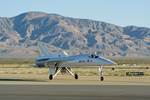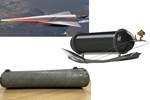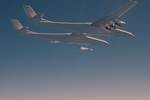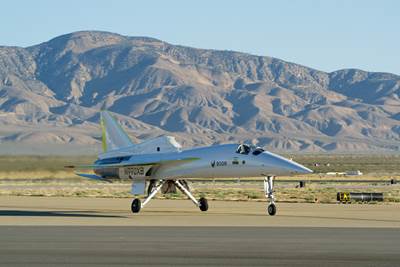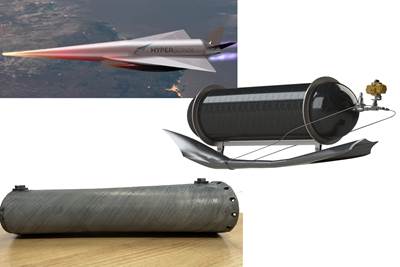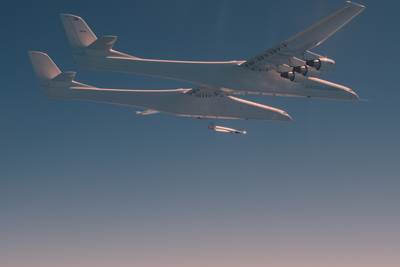NASA moves into next phase of high-speed supersonic travel project
Under the Advanced Air Vehicle’s Program, Boeing- and Northrop Grumman-led teams are charged with developing technology roadmaps with vehicle concepts that can operate at Mach 2+ speeds.
Concept illustration of a Boeing high-supersonic commercial passenger aircraft. Photo Credit: Boeing
(Washington, D.C., U.S.) has issued 12-month contracts to two U.S. aerospace industry teams to study technology for sustainable high-speed airliner designs capable of Mach 2+ under the research agency’s Advanced Air Vehicle’s Program (AAVP).
The teams, led by Boeing (Arlington, Va., U.S.) and Northrop Grumman (Palmdale, Calif., U.S.), are charged with developing technology roadmaps covering key elements including airframe, power, propulsion, thermal management and composite materials that can operate at high Mach speeds. The teams also have been asked to develop designs for concept vehicles.
AAVP “studies, evaluates and develops technologies and capabilities for new aircraft systems … to enable new aircraft to fly safer, faster, cleaner, quieter and use fuel far more efficiently,” according to the NASA website. The program has been exploring whether the commercial market could support travel at four times faster than what is currently possible.
The company recently investigated a business case for supersonic passenger travel through aircraft that could theoretically travel between Mach 2 and Mach 4 (1,535-3,045 miles per hour at sea level). By comparison, today’s larger airliners cruise at roughly 600 miles per hour, or about 80% of the speed of sound. The studies concluded potential passenger markets exist in about 50 established routes that connect cities. Since the U.S. and other nations prohibit supersonic flight over land, the studies’ findings covered transoceanic travel, including high-volume North Atlantic routes and those crossing the Pacific.
Moreover, NASA’s Quesst mission, with its X-59 quiet supersonic aircraft, aims to provide data to regulators that would help change the overland supersonic flight rules. “We conducted similar concept studies over a decade ago at Mach 1.6-1.8, and those resulting roadmaps helped guide NASA research efforts since, including those leading to the X-59,” Lori Ozoroski, project manager for NASA’s Commercial Supersonic Technology Project, says. “These new studies will both refresh those looks at technology roadmaps and identify additional research needs for a broader high-speed range.”
AAVP is now moving into the next phase of its high-speed travel research, which includes issuing two contracts to companies to develop concept designs and technology roadmaps. The roadmaps will explore air travel possibilities, outline risks and challenges and identify needed technologies to make Mach 2+ travel a reality.
Boeing’s team includes supersonic aircraft developer Exosonic (San Jose, Calif., U.S.), GE Aerospace (Cincinnati, Ohio, U.S.), Georgia Tech Aerospace Systems Design Laboratory (Atlanta, U.S.), Rolls-Royce North American Technologies (Indianapolis, Ind., U.S.) and others. Northrop Grumman Aeronautics Systems is leading the second team with partners Blue Ridge Research and Consulting (Asheville, N.C., U.S.), Boom Supersonic (Denver, Colo., U.S.) and Rolls-Royce North American Technologies.
“The design concepts and technology roadmaps are important to have in our hands when the companies are finished,” Mary Jo Long-Davis, manager of NASA’s Hypersonic Technology Project, notes. “We are also collectively conscious of the need to account for safety, efficiency, economic and societal considerations. It’s important to innovate responsibly so we return benefits to travelers and do no harm to the environment.”
Once the industry engagement phase is completed, NASA and its industry and academic partners will decide whether to continue the research with its own investments.
Editor’s Note: Supersonic developments will most likely impact lightweight materials like high-temperature carbon fiber-reinforced polymers (CFRP) and ceramic matrix composites (CMC). Read:
- “Nanomaterials optimize performance of space-ready carbon fiber composite panels”
- “High-temperature composite 3D printing facilitates design, manufacture of deployable space structures”
- “Bridging the gap between CFRP and CMC”
Related Content
Plant tour: Collins Aerospace, Riverside, Calif., U.S. and Almere, Netherlands
Composite Tier 1’s long history, acquisition of stamped parts pioneer Dutch Thermoplastic Components, advances roadmap for growth in thermoplastic composite parts.
Read MoreWelding is not bonding
Discussion of the issues in our understanding of thermoplastic composite welded structures and certification of the latest materials and welding technologies for future airframes.
Read MorePlant tour: Aernnova Composites, Toledo and Illescas, Spain
RTM and ATL/AFP high-rate production sites feature this composites and engineering leader’s continued push for excellence and innovation for future airframes.
Read MoreThe next-generation single-aisle: Implications for the composites industry
While the world continues to wait for new single-aisle program announcements from Airbus and Boeing, it’s clear composites will play a role in their fabrication. But in what ways, and what capacity?
Read MoreRead Next
Boom Supersonic advances flight preparations for composite XB-1 demonstrator
Since its rollout in 2020, the supersonic demonstrator has claimed several achievements, including a recent experimental airworthiness certificate and authorization for test pilot flights, further validating Overture’s development.
Read MoreHypersonix receives CMC scramjet manufacturing demonstrator
HTCMC component demonstrates manufacturing of future Spartan scramjet engine required for reusable hypersonic vehicles capable of up to Mach 12 flight.
Read MoreStratolaunch completes separation test of Talon-A hypersonic vehicle
Stratolaunch takes one step closer to hypersonic flight with the demo of a clean and safe separation of its Talon-A vehicle from the Roc aircraft platform.
Read More
